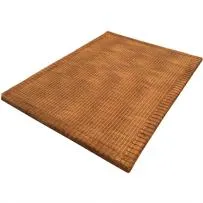fibc bag producing line
The Evolution and Efficiency of FIBC Bag Producing Lines
Flexible Intermediate Bulk Containers (FIBC), commonly known as big bags or bulk bags, have become an essential part of the packaging industry due to their versatility and efficiency in handling a variety of materials. The production of FIBC bags involves advanced manufacturing processes that ensure consistency, durability, and cost-effectiveness. This article explores the intricacies of FIBC bag producing lines, highlighting their components, operations, and the benefits they provide to manufacturers and end-users alike.
Understanding FIBC Bags
FIBC bags are designed for the storage and transportation of bulk materials. These bags are made from woven polypropylene, providing a robust structure that can hold significant weight. They are widely used in various industries, including agriculture, construction, chemicals, and food processing, thanks to their ability to safely contain and transport diverse materials.
The Production Line Components
The production of FIBC bags involves several key components that work in harmony to create high-quality products. The main stages of a producing line include
1. Raw Material Preparation The process begins with the selection of high-quality polypropylene granules. These granules are melted and extruded into thin fibers through spinning nozzles, forming woven fabric that will eventually be used to construct the FIBC bags.
2. Weaving The woven polypropylene fabric is produced using specialized weaving machines. This process involves interlacing the polypropylene fibers to create a sturdy, breathable fabric. The quality of the weaving is critical, as it determines the strength and durability of the finished bag.
3. Cutting and Shaping Once the fabric is woven, it is cut into the desired dimensions based on the specifications of the bag. This stage may also include pre-sewing processes to prepare the fabric for assembly.
fibc bag producing line

4. Sewing The cut fabric pieces are then sewn together using industrial sewing machines. This is a crucial step because the seams must be strong enough to withstand the stresses of transporting heavy loads. Advanced sewing techniques, such as high-frequency welding, can also be employed to enhance the integrity of the seams.
5. Finishing After the sewing process, the bags may undergo various finishing processes, including the addition of special features like liners, coatings, or printing. These enhancements can improve the functionality and branding of the bags, catering to specific customer needs.
6. Quality Control The final production stage involves rigorous quality checks to ensure that each bag meets the required standards for durability, capacity, and safety. This includes testing for load capacity and checking for any flaws in the material or construction.
Benefits of Automated Production Lines
The adoption of automated FIBC bag producing lines has revolutionized the manufacturing process. Automation enhances efficiency by reducing human intervention, leading to faster production times and lower labor costs. Furthermore, automated systems can ensure consistent quality control, minimizing the chances of defects and ensuring that each bag meets industry standards.
Additionally, automated production lines can accommodate different bag designs and specifications with minimal downtime, allowing manufacturers to respond swiftly to market changes and customer demands. This flexibility is a distinct advantage in today’s fast-paced industrial environment.
Conclusion
The production of FIBC bags is a complex process that combines advanced technology, skilled labor, and rigorous quality control. As industries continue to demand efficient bulk packaging solutions, investing in state-of-the-art FIBC bag producing lines becomes paramount for manufacturers aiming to remain competitive. These innovations not only enhance production efficiency and quality but also contribute to the sustainability efforts within the packaging sector by optimizing resource usage and reducing wastage. As such, the future of FIBC bag production looks promising, with ongoing advancements likely to shape the industry in exciting new directions.
-
Industrial Cylinder Arm Sewing Machine: Revolutionizing Heavy-Duty SewingNewsJul.28,2025
-
Cylinder Arm Sewing Machine: Perfect for Special Sewing ApplicationsNewsJul.28,2025
-
Cylinder Bed Sewing Machine: Essential for Sewing Complex MaterialsNewsJul.28,2025
-
Heavy Duty Sewing Machine: The Essential Tool for Industrial ApplicationsNewsJul.28,2025
-
Computerized Pattern Sewing Machine: Revolutionizing Precision StitchingNewsJul.28,2025
-
Heavy Duty Industrial Sewing Machine: Power Meets PrecisionNewsJul.28,2025
-
Leather Sewing Machine: The Industrial Standard for Tough MaterialsNewsJul.18,2025





























